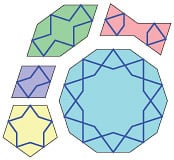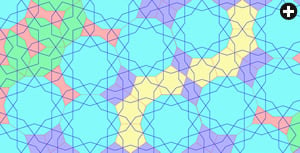
For students: We hope this guide will help sharpen your reading skills and deepen your understanding of this issue’s articles.
For teachers: We encourage reproduction and adaptation of these ideas, freely and without further permission from Saudi Aramco World, by teachers at any level, whether working in a classroom or through home study.
— THE EDITORS
Class Activities
The world is a complex place—so complex, in fact, that it can be hard to see, let alone understand, its many elements and aspects. This Classroom Guide focuses on seeing and understanding complexity, from a multi-layered ancient city that’s modernizing, to the complicated process of saving an animal species from extinction, to the tiling found on some medieval buildings that mathematicians have only recently begun to understand. In the activities that follow, you’ll identify elements of complicated situations and images, explore what makes it difficult to see them in all their complexity, discuss the benefits that come from deeper understanding, and examine the problems that arise when one fails to take complexity into account.
Theme: Understanding Complexity
What are the elements of two specific complex situations?
Both “Istanbul’s Opening” and “Rx for Oryx” describe very complicated situations. The former describes a city that one artist calls “multi-layered.” The latter describes efforts to save the oryx from extinction. Start with “Istanbul’s Opening.” Read the article, which describes the flowering of Istanbul’s arts scene. Working with a group, list the following on chart paper: theater, museums, literature, architecture. After each item, leave space. With your group, fill in the spaces with information from the article about each of the cultural forms/institutions on the list. When you’re done, look at your chart. What does it reveal about Istanbul today? Write an answer on your chart. Make it one sentence that starts: “Istanbul today…” Then compare your chart with another group’s to see if you have similar understandings of the article. Discuss and clarify any differences.
With your group, answer these questions: Do you think there’s a connection between Istanbul’s multi-faceted culture and the fact that half of the city’s population is under 30? If so, what might it be? How do you think your community would be different if half its residents were under 30? Brainstorm what it might be like, and share your ideas with the rest of the class. What does your imagined youthful community have in common with Istanbul? How is it different? What accounts for the differences?
Now turn your attention to “Rx for Oryx.” Read the article. With your group, organize what you’ve read by making a web. In the center, write “Saving the Oryx.” From the center, spin out the many factors that the article suggests must be taken into account in order to achieve the goal of saving the oryx.
Once you’ve done that, spin your web further. Based on the different factors you have identified on your web, what actions have different organizations in the Middle East (including governments) taken to preserve the oryx? Add those actions to the web, connecting each to any specific factors they relate to. Jot down a preliminary answer to the question: “What actions have been taken as a result of seeing the complex circumstances involved in saving the oryx?”
What makes it difficult to see situations in all their complexity? What are the consequences of failing to see many facets of a situation?
When you look at your web, you’ll notice that not every factor on your web was considered in every location where oryx preservation efforts have been undertaken. Based on what you’ve read, discuss which of the factors people have had the most difficulty recognizing. Next to those factors on your web, write why you think it has been so difficult to see them. For example, the Omani government failed to see that tribal tensions might hobble their plan to protect the oryx. Why do you think that was the case? What made it difficult to see that tribal relations might affect the success of the plan to save the oryx? What action might have been taken to prevent the problems that arose? What have other oryx preservation efforts learned from Oman’s experience? What have they done differently as a result?
Then think about the consequences of not seeing the importance of each factor. What, for example, was the unintended consequence of the Omani government’s failure to see the importance of tribal rivalries? How did that consequence affect the success of the government’s oryx preservation plan? Are there other situations in the article where you can see the potential for other unintended consequences? On your web, use another color to write next to each factor what you think might happen if this factor were to be overlooked.
How do stereotypes limit people’s ability to see the complexity of situations and other people?
Turn your attention again to “Istanbul’s Opening.” Part of the article discusses stereotypes. Find a definition for stereotype and write it down. As a class, identify and list the stereotypes that artists in Istanbul confront. How do the stereotypes differ from the artists’ own understanding of their city, country, and region? How do the stereotypes interfere with people’s ability to see Istanbul as it is, rather than how they imagine it to be? Take the role of one of the artists, and write or present orally a statement explaining what the stereotypes are, what problems they raise for you as an artist and how you deal with them. Use the information in the article from artists, as well as your empathetic imagination, to complete the task.
To find out one way that people are dealing with stereotypes, read “The Art of Volunteerism”. Working in pairs, imagine one of you is a person in the living library, while the other is a borrower. How would you feel as the borrower? How would you feel if you were the person being questioned by the borrower? Do you imagine that the living library is effective in combating stereotypes? If so, what makes it effective? If not, why don’t you think it would work?
What are the benefits of seeing a situation in its complexity? What difficulties arise from seeing it that way?
“Istanbul’s Opening” says that artists find the city’s complexity beneficial as well as challenging. Elif Shafak put it this way: “This complexity makes the city more difficult to understand but all the more stimulating for artists and writers. Wherever you turn, there are stories piled up.” Use information about Istanbul and one of the examples of art created there to illustrate Shafak’s point. Make notes and have volunteers present their analyses to the class. As a class, discuss whether you think the benefits of understanding Istanbul’s complexity outweigh the difficulties, or vice versa.
Think back to the oryx. You have already considered some of the problems that arose from not seeing the facets of the situation sufficiently. Now look at the article and at your webs and answer the question: “How have efforts to save the oryx been helped by a thorough understanding of the circumstances in which preservation efforts have taken place?” Write your answer as an informational caption that could accompany one of the photographs in the article.
Of course, it’s not always easy to tell whether something is an advantage or a disadvantage. “Rx for Oryx” raises challenging questions about how preservation efforts are affecting the oryx population—and not just the numbers of oryx that exist, but how they behave. Re-read the part of the article that addresses how eco-tourism has changed the oryx habitat and consequently oryx behavior. What are some of those changes?
Visual Analysis
 |
| The kites and darts that can be combined to make a non-periodic Penrose quasicrystal pattern originate when an isosceles triangle is inscribed within a pentagon (top). Notice that the result is not one triangle but three: the isosceles triangle (dark tint) and two identical obtuse triangles (light tint). The two obtuse triangles combine to make a kite; two of the isosceles triangles combine to make a dart. |
 |

In the preceding activities, you have looked at the difficulty, and the value, of understanding the complexity of situations. What about visual complexity? “The Tiles of Infinity” shows and explains an excellent example. To conduct this visual analysis, you will first need to read “The Tiles of Infinity.” You may wish to do so with a partner so that you can discuss any parts you don’t understand. Highlight in the article the explanation of the Penrose quasicrystal pattern, and what makes it unique. To help you understand it, let’s look at some of the visual images and the captions that describe them. At right are two of the shapes that Penrose identified as making possible non-periodic tiling: “kites” and “darts.” Look at the two shapes and read the caption that explains how they are formed.
Then look at five shapes (right) that can be made from these two basic shapes. Label the hexagon, bowtie, decagon, rhombus and pentagon. Trace with your finger or a pen the kites and darts that make up the shapes. Notice the colors that have been given to the shapes—you will use them to analyze the next image.
Then look at the image at right from the Topkapı Scroll. With your partner, or as a class, use the color coding for the five shapes to locate and identify them. What do you notice about any patterns the shapes create? What you observe should fit with the explanation of Penrose patterns that you read. Does it? Next, look at the solid blue lines. What do they show? How do they relate to the different-colored shapes you’ve already identified? Write a sentence that explains what the solid blue lines show. Then look at the dotted red lines. What do they show? What can you perceive in the tiling because the dotted red lines are there? Write another sentence, this one explaining what the dotted red lines show.
Now that you can see some of the complexity of the Penrose patterns, think about some of the questions you considered earlier about the value of such understanding. How does seeing and understanding the Penrose patterns affect your perceptions of the tiling on the buildings that the photographs show? Does it increase your appreciation for the tiling? Would you want to explain to someone who doesn’t know about Penrose quasicrystal patterns what you can see in the tilings? Or maybe you find that knowing about the underlying complexity of the tiling affects you in a negative way. If so, explain how it affects you and why you don’t like it. Overall, do the benefits of understanding the Penrose pattern outweigh the difficulties, or vice versa? Why?
| Julie Weiss is an education consultant based in Eliot, Maine. She holds a Ph.D. in American studies. Her company, Unlimited Horizons, develops social studies, media literacy and English as a Second Language curricula and produces textbook materials. |